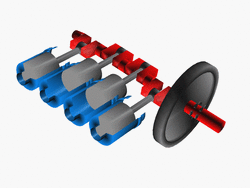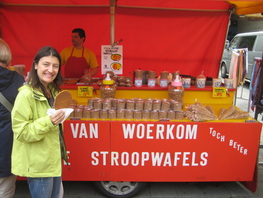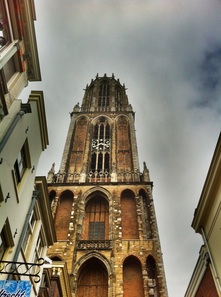


Windmills have been a part of Dutch life for around 1,000 years. A low-lying country rich in rippling winds, it makes sense that the windmill would thrive in the Netherlands. Prior to 1594, however, windmills had limited applications. This is because the circular motion of the windmill would translate only into circular movements of the corresponding gears – useful for milling and irrigation, but not for much else. But one man would change the face of windmills forever and in doing so, would launch an empire.  Crankshaft Cornelis Corneliszoon van Uitgees is described in the sparse texts we have about him as a simple farmer trying to support his family. But he had an idea. Corneliszoon reasoned that if you combined a simple crankshaft (pictured right) with the windmill’s engineering, you could convert the circular movements of the windmill into the back and forth motion needed to power a saw. In 1594, he built his first saw mill and immediately he could cut the same amount of wood in one day as it would take 50 men to cut in that same amount of time.  Another Dutch invention - stroopwaffles! This one innovation launched a huge construction boom at the shipbuilding yards as the Dutch suddenly had more processed wood than any other culture in the world. They constructed thousands of ships over the next 150 years and dominated global commerce as their empire spread across the globe. Who would have known that such a major change in the world could come from a seemingly small improvement to the windmill? It’s particular interesting to note that Corneliszoon didn’t invent either the windmill or the crankshaft. Like many inventors, he didn’t produce something entirely new so much as realize that two existing things could be combined to DO something entirely new. Neda and I have been interested in the delicate circumstances that must exist for someone to make a breakthrough of this type. For instance, all the technology needed to produce a steam engine existed during the Roman Empire, though the first workable steam engine wasn’t produced until the early 18th century. It took thousands of years until Thomas Newcomen figured out how to combine the technology in a way that worked. For us inspiration lies within the possibilities these stories suggest. What materials and ideas can be combined in our day and age to produce changes we never thought possible? From a spiritual perspective, does the key to your happiness not lie in something outside of yourself, but in just effectively combining the many tools you already have? It was these questions and more that journeyed with us as we explored the wonderful country of the Netherlands. We started with an anniversary weekend in Soest, a small town that houses the Soestdijk Palace as well as a working windmill. Our visit to the windmill and discussion with the millman there prompted the post above. We also went sailing with our CS host Max in the beautiful inlet to the North Sea created by the Zuiderzee Works, an engineering marvel by which the Dutch created "new land" in the early 20th century.  The Dom Tower before a rain From Soest, we traveled to Utrecht, a university town in the center of the Netherlands. For me it was a reunion of sorts, as this year marks the 10th sine I studied abroad at Utrecht University with several close friends from college. Though none of them could make it to Utrecht at the same time, we visited many of our old haunts (Café Belgie, the “Culture” Boat, ACU, the Dom tower, and of course, Mr. Jack’s). We also biked along the Oudegracht canal to Castle Zuylen, passing the canalboat red light district along the way. Special thanks to Catherine, our CS host for her company, restaurant recommendations, and for teaching us how to make homemade paneer! Utrecht led to our last city of the tour, Amsterdam. The cultural capital of the Netherlands is teeming with life. We met up with our traveling buddy Shea to explore the rambunctious streets of the canal lined city. Visits to the Van Gogh Museum and Anne Frank house were interspersed with delicious beers at Brouwerij’t IJ with our CS host Eran as well as visits to coffeeshops like De Dampkring, where Brad Pitt and George Clooney filmed Ocean’s 12. Old Memories mixed with new on this part of the trip, and just like Corneliszoon’s windmill, who knows what the new combination will create inside of us? For now we’ll have to wait and see as we prepare to jump across the channel and stage our own British Invasion! See pics of Soest and Utrecht here: http://flic.kr/s/aHsjAboB45 and pics of Amsterdam here: http://flic.kr/s/aHsjAbqUGd.
0 Comments
Leave a Reply. |